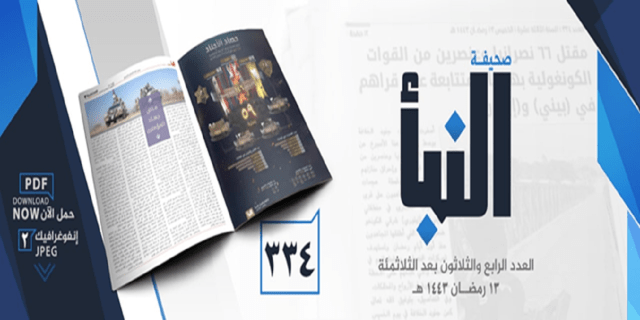
Author: Daniele Garofalo
Through the analysis of the weekly issue N. 334 of the al-Naba newsletter, the official media product of the Islamic State, it is possible to assess the threat in operational terms of the jihadist organisation in Eurasia.
Propaganda and operations
The issue n. 334 refers to the week from Thursday, April 7th, 2022, to Wednesday, April 12th, 2022. From a general point of view, it is possible to assess that al-Naba inserted within the weekly magazine a significant part of the claims already published daily during the week just passed, adding some new elements or more details, both written and photographic. However, it often happens that al-Naba also inserts claims or messages that have not been previously published.
Following the usual editorial line, after the introductory page, the infographic summarises all the operations carried out during the mentioned week, the main editorial, and then all the operative details with relative photos. As far as our analysis context is concerned, the Eurasian areas involved in operations last week were: Iraq, Syria, Afghanistan and Pakistan. The number of dead and wounded indicated by the Islamic State are 31 in 6 Iraqi sub-provinces/sectors, 12 between Afghanistan and Pakistan and four in Syria, with about a dozen military vehicles and barracks burnt or destroyed in all the areas indicated.
Entering the details of the typology of attacks, operations and targets of the Islamic State fighters, who follow the two main strategies of “war of attrition” and “economic warfare”, we can note the following:
- Iraq: operations were conducted in six sectors: Salah al-Din, Tigris/Dayla, North Baghdad, Diyala, Anbar and Kirkuk. The Islamic State targeted convoys, barracks and checkpoints of the Iraqi Federal Police, Popular Mobilization Forces, Shiite militias and Iraqi Swat Forces with direct assaults, Improvised Explosive Devices (IEDs), and targeted assassinations. As part of the “economic warfare” strategy, an electricity tower within the Salah al-Din-Kirkuk line in the Riyadh region and a fuel station in western Anbar was demolished with explosives (first, they stole the fuel, then they destroyed it).
- Afghanistan: Islamic State struck in Kabul, where they targeted the Taliban and in the city of Kunduz, capital of the province of the same name, where they conducted an operation that belongs to the strategy of “economic warfare” that led to the destruction of an electric tower with explosives.
- Pakistan: in Mamund, in the district of Bajaur, in the province of Khyber Pakhtunkhwa, Islamic State fighters assassinated a former Pakistani policeman.
- Syria: Attacks were conducted in the governorate of Deir el-Ezzor, mainly targeting pro-Assad and Kurdish militias, through attacks on checkpoints, barracks and a civilian (accused of being a spy), with direct assaults, IEDs and targeted assassinations.
Conclusions: Impact and implications
If we compare the current al-Naba issue with those of the past weeks, it is possible to note an apparent decrease in the organisation’s operations in Eurasia, both in military operations and in areas affected. The operational activity’s reduction is unusual during Ramadan when usually the Islamic State increases its operations considerably. At the same time, it should not impress or lead to misjudgments about the strength and status of the organisation. Indeed, many times in the past, the Islamic State in different areas decreased its operations because it was preparing for large and violent operations. It has also often happened, as in the case of Syria, that to maintain a lower profile, not all the operations conducted were claimed.
Number 334 confirms a stable presence of the Islamic State in many Iraqi areas, stability in the Syrian areas, and a constant presence (contrary to what the Taliban claims) in AfPak (the affected Pakistani area is part of the operations of the Wilayah Khurasan).
In addition, one notices the ability to carry out attacks in different ways, to hit different targets and to succeed in every way in creating chaos and difficulties with both of its main strategies, with that of “economic warfare”, which, particularly in Iraq and Afghanistan, creates problems for central governments and discontent in areas where the Islamic State exploits popular discontent for support and recruitment.
Author: Daniele Garofalo
Disclaimer: the project Monitoring Jihadist Propaganda & Terrorism is for academic and research purposes only and does not endorse any posted material. Request a full SpecialEurasia report on the Islamic State propaganda by contacting us at this Link.
